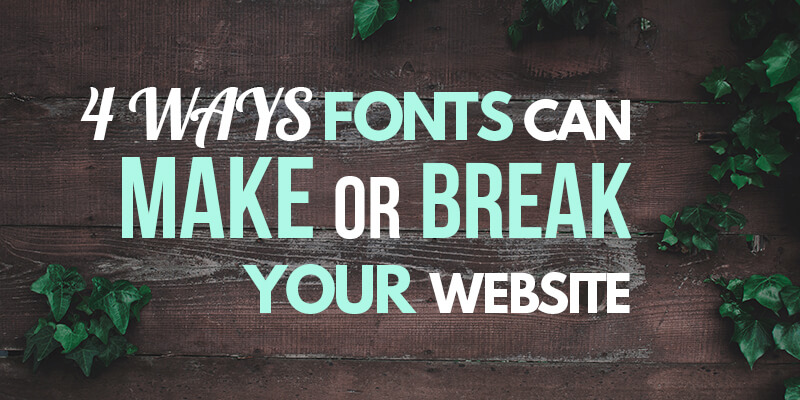
4 Ways Fonts Can Make or Break Your Website4 min read
August 21, 2018There are a wide variety of factors to consider when designing a new website; imagery, color scheme, call-to-action button style, and overall layout are all essential to your website’s success and lead generation. These are all heavily scrutinized by designers and clients alike. A vital decision that is often overlooked, however, involves font choice.
Fonts can truly tie a website together and even influence a user’s behavior, making them a crucial part of the design process. Certain fonts should make key phrases jump out by being bold or unique, while others need to be comfortable to read in paragraphs. Typographical hierarchy is essential as well, leading the user along a designated path through the page’s content and drawing attention to specific pieces without distracting from the main text of the page. The science behind effective typography goes deep, but here we’ll focus on just 4 ways that font choice alone can affect the performance of your website.
- One of the most important font choices is in regard to headings. Headings need to stand out and act as a divider between sections of a page without being overbearing or detracting from call-to-actions or the main body text. This is where a careful balance between uniqueness and hierarchy comes into play, while also considering what matches your brand. Headings can be either serif or sans-serif, depending upon what goes better with your business model, but must always have a more distinct presence and size than that of the rest of your site. Modern sites tend to go with a sans-serif font, but there are plenty of occasions or businesses that work well with a serif style. Raleway and Lobster are commonly used fonts for beautiful, stand-out headings that maintain a healthy hierarchical balance. For example:
This is the Lobster Typeface, A Great Font for Bold Headings!
- Call-to-actions are also vital to your website design strategy. This font can be the same as what is used for headings or body text, but utilizing another variant is certainly acceptable and sometimes the optimal approach if the heading font is a script font or does not otherwise work well in a smaller size. This font still needs to stand out, but at either the same size or not much larger than the body text so that your call-to-actions do not distract from the heading, the body, or from any actionable buttons. This is done usually by a heavy font weight, italics, or a combination thereof. Buttons also need to attract a user’s attention, and the font utilized can impact the effectiveness of a button greatly.
- Body font is usually simple; a complicated font is not recommended for text that could be taking up multiple paragraphs on a single page. A straightforward, simple, and comfortable-to-read font is important for this purpose. If a user is not comfortable reading a significant amount of text with a particular font, it shouldn’t be used for the body text. Traditionally, this means no script or handwriting styles, as they can both be overwhelming in large quantity. A very popular option is Open Sans, due to its flexibility with styles and elegant simplicity, which compliments most font choices for headings and call-to-actions.
- It is important to always consider a mobile view when designing a new site. Be sure to examine whatever font decisions are being made in a mobile environment as well. A font that looks fantastic on a desktop may not look so great when viewed on a much smaller format, such as a phone. This is another reason many newer sites will stick with a clean, simpler font as opposed to complex, scripted ones. Those fonts have their place and there are some excellent options out there. Always test various form-factors to ensure the all-important hierarchy is maintained, regardless of the final font choices.
There are countless factors to consider when selecting fonts, but these 4 will put you on the path to an elegant website that emphasizes proper user interaction and provides a comfortable reading experience for the primary content. In conjunction with a strong layout, following these guidelines will provide a pathway to push the user through each page of your site, allowing for more effective communication and superior lead generation. While other considerations for a new website design tend to get the most attention, fonts deserve significant thought as well.